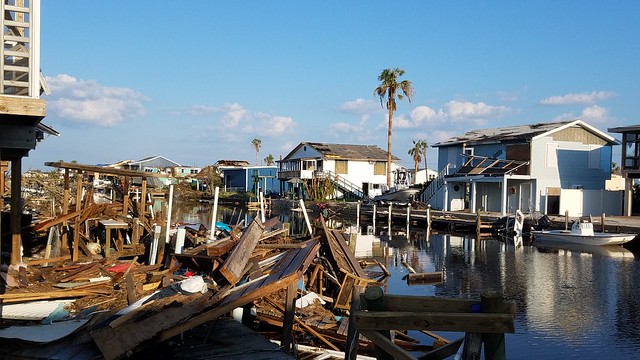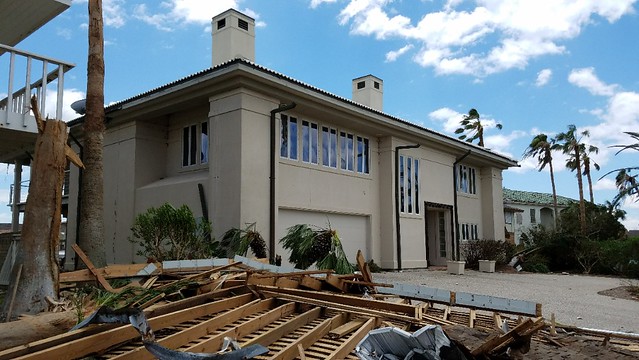Auburn professor deploys to hurricane-struck areas to gather data in hopes of lessening future damage
Article body
As hurricane-ravaged communities work to put their lives back together and begin rebuilding, structural engineers like Auburn University Assistant Professor David Roueche rush to the scene to gather research data that could help communities withstand future hurricanes.
The aftermath of these storms is a critical opportunity. Roueche traveled to the southern and northeastern coasts of Florida from Sept. 13-15 and to the Rockport/Corpus Christi, Texas, area from Aug. 28-31 to collect data that could be used to fortify and protect buildings during storms.
Roueche's research in the Department of Civil Engineering focuses on the effect of major weather events on communities and damage to the nation's infrastructure.
"The end goal is to help strengthen our communities by securing buildings from hurricanes like these and preventing the extent of the damage we see now," Roueche said.
Working collaboratively with team members from other universities, he assessed in detail more than 900 buildings and investigated damage patterns to understand why some buildings failed at much higher rates than others. In particular, the team studied the differences between older buildings and homes that were not built according to code and newer buildings and homes that followed building code.
"My first impression was that there was a clear difference between the older buildings and the new, code-compliant buildings, to the extent that in multiple cases you would have nearly untouched buildings next to completely demolished buildings," he said.
On Marco Island, Florida, where the eye of Irma came ashore, the building codes the state adopted in 2002 proved to work well. There were few houses with structural damage despite the havoc on trees and vegetation, while older houses in Naples, Florida, and on the east coast of the state suffered significant roof damage, according to Roeuche. Investigations are still ongoing in the Florida Keys.
In Texas, there were greater variations of damage among buildings, which the researchers are analyzing.
"Newer homes that were built according to code did perform much better, but even some homes that we saw in Harvey that were built to code still suffered significant root damage and structural issues," Roueche said. "We're trying to understand why the damage happened and if there's anything that needs to be updated in the code, or if we need to make homeowners more aware."
Roueche plans to combine and analyze the data for industry newsletters in the near future and peer-reviewed journals later. Publishing data such as Roueche's can be used to improve building design and to make the public aware of the benefits of strengthening their buildings against extreme winds.
"We often wonder whether the public knows what performance to expect from a code-compliant building in high wind speeds," he said.
Roueche worked in Texas with faculty members from the University of Maryland, the University of Illinois and James Cook University, Australia. In Florida, he partnered with faculty members from Notre Dame, Florida International University, the University of Florida and the Florida Institute of Technology.
The teams examined large samples of buildings to determine what causes the differences in performance between houses that withstood the storm and houses that suffered. The use of the Fulcrum app, a mobile data collection platform, allowed the team to collect and share the data publicly faster than ever before.
In regard to protecting homes and property from future storms, Roueche said people should evacuate if instructed to do so, and the "most important thing" homeowners can do to prevent damage is to protect windows.
"Secure your windows with boards or shutters and brace the garage door with horizontal bars," he said. "Any large openings left can enhance the wind load and cause the building to fall."
Hurricane Harvey made landfall in Rockport, Texas, but smaller areas, such as Holiday Beach, just north of Rockport, lacked the recovery assistance and attention Rockport received.
"I was quite surprised by the lack of media coverage," said Roueche. "It felt like the media was in such a rush to cover Houston and Rockport that some of the areas with great needs may have been largely ignored."
Homeowners in smaller areas that receive less media coverage are advised to report damage in their area to local emergency officials.
"Letting them know that you're in need of help is the biggest thing," Roueche said.
Related Media
Media interested in this story can contact Communications Director Preston Sparks at (334) 844-9999 or preston.sparks@auburn.edu.
Auburn University is a nationally ranked land grant institution recognized for its commitment to world-class scholarship, interdisciplinary research with an elite, top-tier Carnegie R1 classification, life-changing outreach with Carnegie’s Community Engagement designation and an undergraduate education experience second to none. Auburn is home to more than 30,000 students, and its faculty and research partners collaborate to develop and deliver meaningful scholarship, science and technology-based advancements that meet pressing regional, national and global needs. Auburn’s commitment to active student engagement, professional success and public/private partnership drives a growing reputation for outreach and extension that delivers broad economic, health and societal impact.








